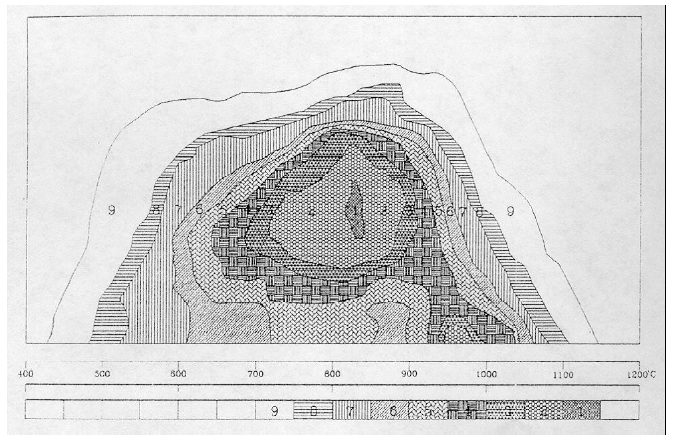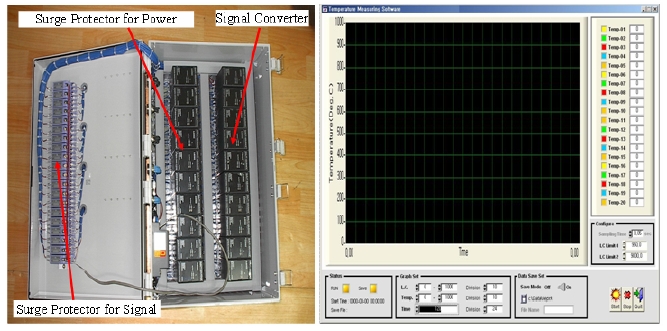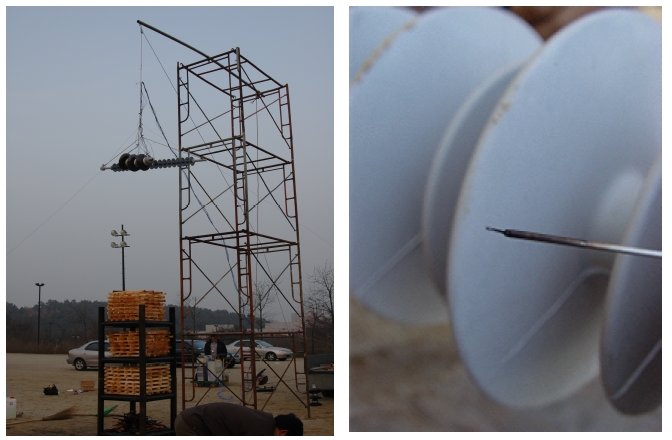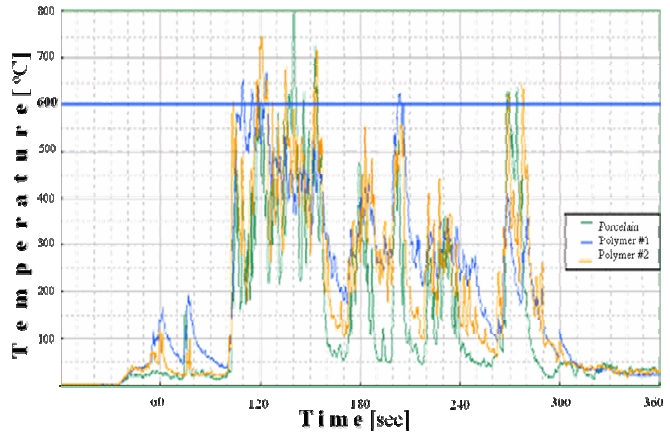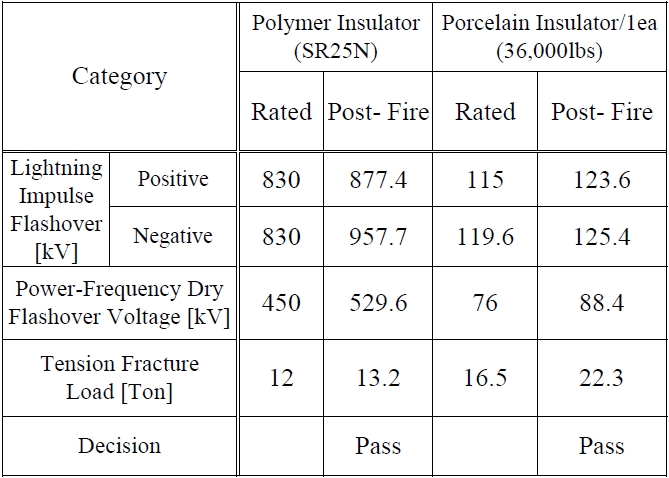



There are approximately 7.2 million power transmission insulators currently in service in Korea. Approximately 48%, or 3.4 million of these insulators were manufactured domestically and approximately 52%, or 3.8 million units, are imports. In terms of the type of materials used, the vast majority of insulators are porcelain-based (99.4%) with approximately 40,000 glass insulators in service. As far as polymer insulators are concerned, they were first imported in 1999 and tested on a 154 kV line. Between the period of 2002 and the present, 2,445 domestically manufactured polymer insulators have been installed. Polymer insulators are prohibited from being used in areas with the risk of forest fire and can only be used in cities, industrial complexes, plains, open fields, and other areas with no threat of a forest fire, with a stain class A or higher, industrial complexes, and other salt and dust areas. Polymer insulators are more likely to break down at relatively low temperatures when compared to insulators made out of porcelain, an inorganic material.
For this reason, the use of polymer insulators requires an assessment of the damage that can be brought on by forest fires and also of the insulators’ reliability. Despite the aforementioned concern for the influence of forest fires on polymer insulators, there is virtually no documented domestic or international research detailing the impact forest fires have on the reliability of polymer insulators used for power transmission applications. Ergo, it is the intention of this study to introduce simulated forest fire conditions to polymer insulators with 154 kV of voltage applied, and to observe the influence the simulated forest fire has on the reliability of the polymer insulators. In addition, the study will compare polymer insulators with the field-proven porcelain insulators in order to increase the reliability of the results [1].
2. THE CHARACTERISTICS OF FOREST FIRES
There are three major considerations when it comes to forest fires in the Korean peninsula. First is the natural environment. 42% of the trees in Korean forests are coniferous trees, which are highly flammable, and the forest floor itself is deeply covered with inflammable leaves, resulting in a fast forest fire spread rate. A second factor is the natural topography. A dense concentration of hills and severe bends further hastens the spread of a forest fire. A third consideration is the weather, in which the influence of the continental climate increases the risk of forest fires in the Korean peninsula [2].
Ambient temperature surrounding the flames during a forest fire generally takes on the form shown in Fig. 1. The maximum temperature at the center of the flame can reach up to 1,200℃ (up to 1,100℃ at the boundaries) and smoke temperatures can surpass the 520℃ mark. In addition, the maximum height of fire columns has been reported to reach as high as 20 m to 30 m off the ground [3], [4].
A forest fire simulation was conducted using wood at GOCHANG Power Testing Center, reconstructing an environment similar to that of an actual forest fire.
Temperature readings from the insulator surfaces were taken using a temperature measuring device that was developed by incorporating signal converters, a data collection and storage device, surge protection devices, etc (see Fig. 2).
KEPCO’s transmission line design specifications [5] state that the insulator’s height should be determined based on 35 years of use and factor in the ground clearance standards for each type of tree. This ensures that, in the event of an actual forest fire, the insulators attached to the pylons are not positioned at the center of the flame and therefore subjected to the maximum temperature of the ambient smoke (520℃).
In this study, an additional 20% leeway was given on top of this to facilitate even harsher testing conditions thereby adjusting the maximum temperature of the flame so that the insulator surface temperature would reach 600℃ to 630℃. It was possible to acquire the desired temperature conditions by adjusting the flame through numerous trials with various wood quantities and installation height configurations.
The forest fire simulation tests were performed with polymer (SR25N) and porcelain (36,000 lbs) insulators. They are both domestically manufactured insulators that are currently being used by KEPCO on 154 kV power transmission lines [6].
[Table 1.] The characteristics of the test sample.
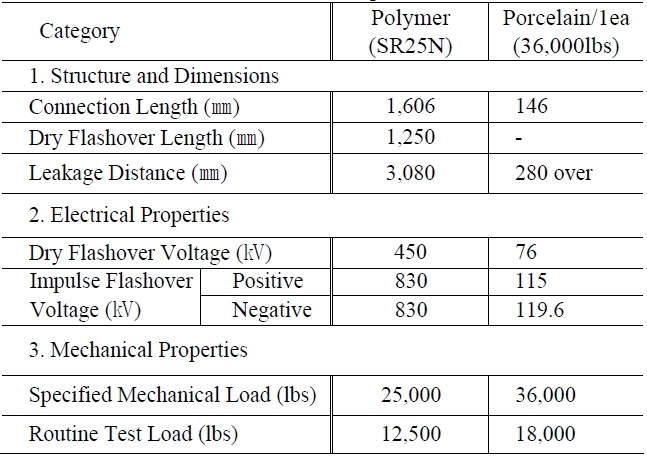
The characteristics of the test sample.
3.3 The forest fire simulation setup
The forest fire simulation test was conducted for the purpose of measuring the simulated forest fire’s flame temperature during the simulated forest fire. It was performed with polymer (SR25N) and porcelain (36,000 lbs) test sample insulators. Figure 3 shows the scene of the simulated forest fire test at GOCHANG Power Testing Center. In Fig. 3(a), the minimum height of the arm was 6 m and the polymer insulator was approximately 2 m long. The structure itself measured 1.5 m(l)×1.5 m(w)×2.5 m(h). There was a 1 m gap between the wood and the insulator. In addition, Fig. 3(b) shows the temperature sensor, which was installed on the surface of the polymer insulator. There were two sensing points. The first one (#1) was attached to the center of the insulator. The other (#2) was attached above the shed to the insulator’s rod. In case of the porcelain insulator, there was one sensing point. It was attached to the center of the insulator.
4. THE EXPERIMENT AND OBSERVATIONS
Figure 4 depicts time-lapsed photos from the forest fire simulation test using wood.
Figure 4(a) shows the fire column engulfing the setup during an early stage of the simulation. Figure 4(b) reveals the condition of the polymer insulator when it was subjected to high heat. The silicon insulator’s caps, which were closest to the flame, were severely crushed, whereas no particular deformation could be seen on the insulator made out of the inorganic porcelain. Figure 4(c) shows that the crushed caps of the polymer insulator were significantly restored back to normal following the completion of the simulation. The silicon insulator was made out of a fire retardant rubber, whose inherent flexibility caused the caps to deform at 600℃ and above. This flexibility, however, was also responsible for the restoration of the caps back into shape once the heat source had been removed [7].
Figure 5 graphs the temperature characteristics from the simulation test. The temperature readings, which were gained from the temperature sensor, temporarily reached a reading of approximately 750℃ on the polymer insulator and approximately 800℃ on the porcelain insulator during the middle stage of the test.
[Table.2.] The post-simulation electrical and mechanical properties.

The post-simulation electrical and mechanical properties.
The flame, which was fueled by wood, subsided after approximately 300 seconds, and the test samples returned to normal temperatures after approximately 500 seconds. The temperature was maintained at within 300℃ to 400℃ for approximately 120 seconds and then sloped down to the 100℃ vicinity thereafter. Because these temperature readings were taken from the temperature sensor, the temperature of the insulator surface, which was closer to the flame, carried an even higher distribution and was estimated to have reached approximately 600℃ for approximately 60 seconds.
Table 2 is a summary of the comparison values between samples tested in the forest fire simulation at the GOCHANG Power Testing Center.
Lightning impulse flashover, power-frequency dry flashover voltage, and tension fracture load tests were conducted on the tested polymer insulator to determine its electrical characteristics. These electrical property results attest that no crack formation or any other abnormality took place on the silicon housing, which is the insulating material of the polymer insulators, and that, since no change in the dry flashover distance took place, no permanent crushing or deformation was caused by the flame. Similar electrical values from post-simulation were also recorded for the porcelain insulator, indicating little influence from the simulated forest fire. The polymer insulator and porcelain insulator both exceeded the rated characteristics as defined by KEPCO.
This value remained well above the specification value for a new product as set forth by KEPCO and is therefore deemed to have little effect on the insulator’s reliability.
A forest fire simulation test was conducted to determine the reliability of polymer insulators as they relate to Korea’s forest fire characteristics.
The simulated forest fire provided temperature readings that were analyzed as part of an evaluation of the sample insulators’ post-simulation electrical and mechanical properties.
(1) It was found that the simulated forest fire had no significant impact on either the polymer insulator or the porcelain insulator. In summary, a real-life forest fire would be expected to result in a 600℃ or so of flame grazing by the insulators for less than one minute, which should have virtually no effect on the performance of the polymer insulators.
(2) Post-forest fire simulation values for lightning impulse flashover, power-frequency dry flashover voltage, and tension fracture load tests were all above specification levels in both the polymer and porcelain insulators.
(3) By comparing the relatively new polymer insulators with the time-tested porcelain insulators, it was determined that the polymer insulators feature superior characteristics over porcelain insulators and that no particular problem is associated with using polymer insulators in 154 kV power transmission line applications.
